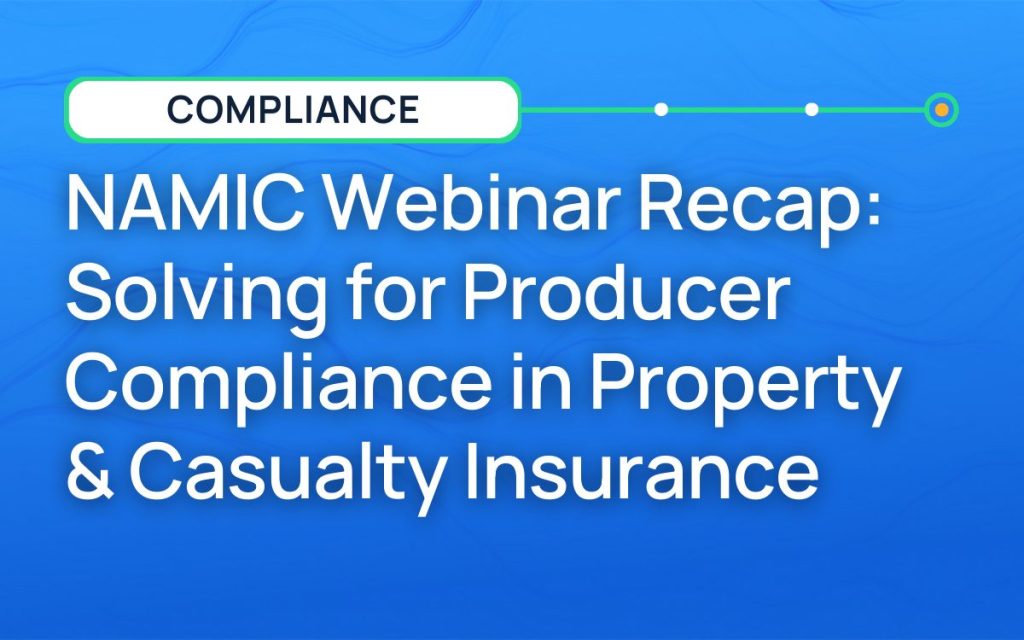NAMIC Webinar Recap: Solving for Producer Compliance in Property & Casualty Insurance

Insights from NAMIC’s compliance webinar presented by AgentSync Solutions Architect Sandy Allen
Did you know there were more than 250 changes to insurance regulations in the U.S. just last year? Or that insurance regulators issued more than $20 million in fines in 2022? If these facts aren’t an incentive to keep your entire distribution network in compliance, we don’t know what is!
These statistics were the fuel behind NAMIC’s August 2023 Webinar “Solving for Producer Compliance” featuring AgentSync’s very own Solutions Architect, Sandy Allen.
Producer compliance responsibilities never end, but they do constantly change, making management an incredibly convoluted task. Compliance professionals must keep up-to-date with ever-changing insurance regulations, and ensure their producers color in the lines.
It’s no wonder that when it comes to producer compliance management, we we often hear sentiments like the following:
“I have been spending hours upon hours manually keeping track of which producers are licensed in which states, for which lines of authority, and when they’re due for CE credits and license renewals. It’s a mess!”
Sure, it’s confusing, but, without accurate and up-to-date compliance checks throughout the entire producer lifecycle, insurance organizations could be exposing themselves to costly fees and regulatory action.
During the webinar, Allen addressed common compliance questions carriers have as they work with producers and independent agencies. Let’s walk through some of her key points including:
- What are registry state appointments?
- How can just-in-time appointments save carriers money?
- What are the licensing requirements for producers and adjusters?
- What is a DRLP?
- And much, much more!
What are a carrier’s requirements for producer onboarding?
From appointments, to license verification, to terminations, it can feel like the duties of compliance never end. In most states, everyone up and down the sales channel is responsible for licensing to some degree. A responsible carrier will do their due diligence concerning:
- Completing background checks for known regulatory or financial malfeasance
- Validating licenses and appointments
- Maintaining an E&O insurance policy
- And collecting tax info for reporting (typically through a W-9)
When it comes to compliance, a carrier’s duties don’t stop after onboarding. Ongoing compliance management includes verifying proper licenses and appointments before commission payouts, maintaining current copies of producer agreements, tracking continuing education and product training, renewing appointments, and much more.
Carriers should complete these checks at every step during the producer lifecycle up to termination. At termination, a carrier’s duties expand even further to include notifying the producer in writing of the intent to terminate an agreement and appointment, as well as terminating the carrier appointment with the states and indicating the cause if necessary.
Appointments 101
Apppointments are a large part of a carrier’s compliance duties because they are how carriers tell states that they work with a particular producer or agency. But, like everything in the insurance industry, appointment requirements and responsibilities vary by state. While many states require appointments and annual renewals, some states don’t require appointments to be filed at all, while others require a one-time (or perpetual) appointment. Simple, right?
How do Registry state appointments differ from other carrier appointment processes?
When talking about Registry state appointments, it’s important you first understand what we mean when we say Registry state. A Registry state doesn’t require carriers to proactively submit their appointments to the state; only that they maintain a list, or internal registry, of the active members of their sales channels.
Today, here are nine Registry states: Alaska, Arizona, Colorado, Illinois, Indiana, Maryland, Missouri, Oregon, and Rhode Island. It’s important to keep in mind that just because a Registry state doesn’t require a carrier appointment, doesn’t mean you should just ignore them. While a Registry state may not require carriers to report their appointments, it still requires a carrier to know who can sell their products, and some, like Rhode Island, will require the carrier to produce an internal registration list for state review annually.
What are Just-in-Time appointments?
Just-In-Time (JIT) appointments allow carriers to wait to execute an appointment (and the fees associated with it) until an agent has actually written business in the state. The main objective of JIT appointments is to allow carriers to increase their distribution without incurring additional costs for agents who aren’t writing business.
To illustrate how JIT appointments save carriers money, Sandy presented the webinar attendees with a simple math problem:
- Say you recruit 100 producers to sell in five states. Assuming an average appointment fee of $20, the cost of appointing those 100 agents is $10,000 (100 x 5 x 20 = 10,000).
- Now, let’s say that half of those producers bind at least one policy with you in the first year in each state they write business, and the other half don’t. In this case, you’ve overpaid at least $5,000 in fees (not including any additional state processing fees).
You can see now how JIT appointments save your company money and are an attractive option during hard market cycles where carriers are looking to cut costs.
What’s a DRLP?
A designated responsible licensed producer, or DRLP, is a producer assigned by a business entity to guarantee compliance with state laws and regulations. All agents working downline at the agency are responsible for reporting to the DRLP, and most states require businesses to submit a record of their DRLP.
Because a DRLP is responsible for ensuring compliance, there are a few criteria that carriers should evaluate when considering their agency partners. Allen noted carriers should consider the following about prospective partner DRLPs: :
- What is their character?
- What is their involvement in the business?
- How often do they meet with other business team leaders?
- Do they have an agnostic source of verification?
- How transparent is their organization?
What are the licensing requirements for adjusters?
Licensing for adjusters is a headache, to put it lightly. Almost all states require licensing for public adjusters. Most states also require licensing for independent adjusters, and some states require licensing for staff or company adjusters. The state nuances around adjuster licensing make it so that adjusters working in various capacities across state lines have a lot of hoops to jump though.
What is an adjuster DHS license?
If an adjuster lives in a non-licensing state, they can choose a designated home state to serve as their resident state. This is known as a DHS license. Adjusters with DHS licenses must complete the pre-licensing and educational requirements of their selected home state.
How can you keep track of state-specific rules?
U.S. insurance compliance is complex. Regulations vary across 56 jurisdictions and those regulations are constantly changing and updating. While each state department of insurance maintains information on its changes and updates, it’s not always easy to find or access online. Additionally, there’s little to no consistency in how each state chooses to present their info.
Staying on top of regulatory compliance is difficult, especially when you’re trying to sift through incomplete and disconnected information sources by hand. AgentSync can help. We’ve created an open-source library to enable producer compliance. Our Compliance Library is intended to provide insurance and compliance professionals easy access to a database of jurisdiction-level information and regulatory updates from across the U.S. insurance industry.
Looking for more support? See how AgentSync revolutionizes producer licensing and compliance processes. Schedule a demo today.

